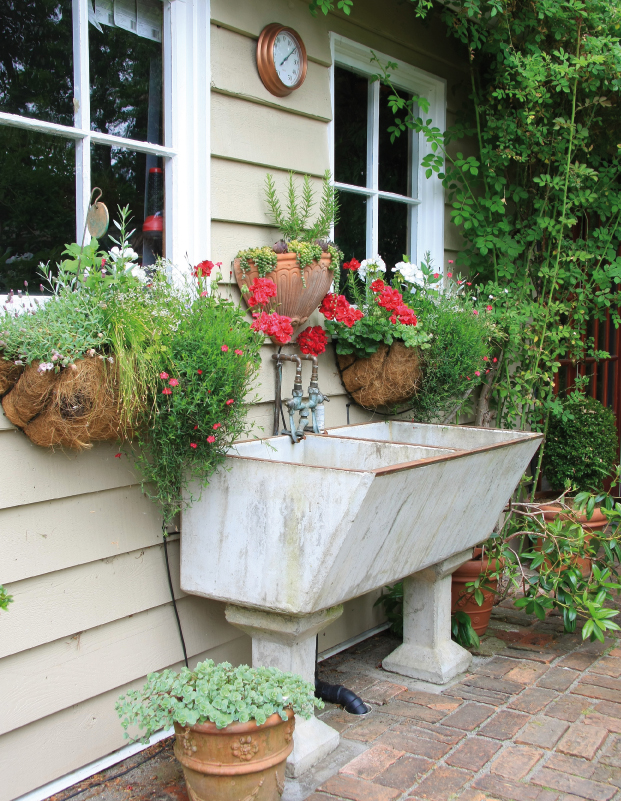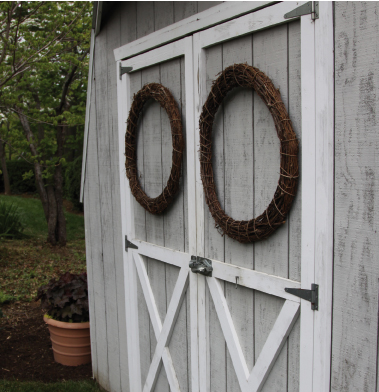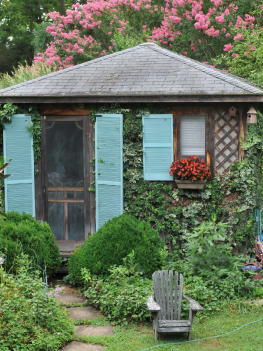The Garden Shed: Meet the Garage’s Sophisticated Cousin
 Several years ago, after driving over the weed whacker as I pulled my car into the garage, flinging the door open smack into the lawnmower, and tripping over a bike on my way into the house, we decided it might be time for change. Sure, some of these mishaps may have been due to haste or bad driving, but we knew we had reached a point where something had to be done about a garage that was too full for our cars. Rather than put the time, effort and money into the organizational aspect of this problem—for some causes are truly lost—we opted to get a garden shed to house our ever-growing collection of outdoor tools and toys.
Several years ago, after driving over the weed whacker as I pulled my car into the garage, flinging the door open smack into the lawnmower, and tripping over a bike on my way into the house, we decided it might be time for change. Sure, some of these mishaps may have been due to haste or bad driving, but we knew we had reached a point where something had to be done about a garage that was too full for our cars. Rather than put the time, effort and money into the organizational aspect of this problem—for some causes are truly lost—we opted to get a garden shed to house our ever-growing collection of outdoor tools and toys.
Now, when I think “garden shed,” I dream of a charming, well-stocked potting room where I can putter and plant in peace. Those big, ugly machines that actually do all the dirty work are parked neatly off to the side. The person I live with, on the other hand, really just wants an easy-to-access dumping ground for the mower, the blower and the grass seed spreader. A place to store the things we don’t want to look at—or run into, or drive over, or trip on—in the everyday comings and goings of our garage. Believe it or not, the ideal garden shed can accommodate both visions with a little forethought and planning.
 First Things First
First Things First
There are many ways to go about obtaining a shed for your backyard. Options range from kits you assemble with a few simple tools, purchased locally or online, to sheds that are preassembled and literally delivered and dropped in your backyard, to buildings that are custom-created just to your liking. The costs associated with each vary as you would expect. But before you even make this decision, however, check with your local municipalities about placing a new shed on your property. Some areas have certain restrictions and require permits for building new structures. (The City of Lynchburg, for example, requires a building permit if you are constructing a new shed of 150 square feet or more.) Restrictions can vary from town to town, so be sure to investigate yours. Furthermore, some neighborhood homeowners’ associations have restrictions and covenants about anything that goes into your yard—so be sure to investigate these details to avoid costly mistakes.
Before choosing a shed, take some time to consider what you really want from it. Take stock of your outdoor possessions and all you might want to store: big-scale items like lawnmowers, snow blowers and weed trimmers; unwieldy items like rakes, snow shovels and sleds; and smaller-scale items like bags of potting soil, seeds, garden gloves and the like. Experts suggest lining everything up on your lawn and measuring it to get a good feel for how much space you need. (For a fun way to figure this out, check out capitolsheds.com, a shed company that services our area, to use their online click-and-drag shed-sizing application, which includes drawn-to-scale images of mowers and shovels that you can place in various-sized sheds.)
To accommodate this range of items, it’s important to have enough floor space, as well as wall space for shelving, cabinets, or pegboard and hooks. Shelving and cabinets can store your smaller garden goodies, while a pegboard would be the perfect place to hang rakes and shovels. A shed with a high or pitched roofline might even lend itself to overhead storage in the rafters (think seasonal items such as skis, sleds, boogie boards).
You also need to think of how you’ll actually use this space. If you want to use the shed for workspace like I dream of doing—planting seedlings or painting old furniture—opt for a shed with a workbench area, and make sure you have enough room to get around the bulky items you’ll be storing to access this area comfortably. If working in the shed is your intention, choose a model with generous windows; you’ll need as much natural light as possible to be able to see the projects you’re working on, as well as to locate items in dark corners (unless you splurge to have electricity installed in your shed, which is a more costly and complicated option). Windows with screens are also important to increase air circulation, particularly if you plan to store fertilizers or other chemicals there.
In considering shed sizes, get the biggest shed you can afford and that your area can hold, because you will most certainly fill it up. Experts say that the most common shed size is around 8 feet by 10 feet.
 Materials, Costs and More
Materials, Costs and More
The budget for your dream shed could be really almost anything, with premade sheds starting at a couple of hundred dollars, all the way to many thousands of dollars for a custom structure, and everything in between. Garden shed materials literally run the gamut, from metal to vinyl to wood, in all colors and finishes. Vinyl and metal cost less initially, and are much lower maintenance than wood options. A shed made of wood may offer a more pleasing aesthetic to your backyard, as it blends into the natural landscape and can be painted to match or complement your home. If you do choose wood, it must be periodically treated and coated with sealers and preservatives to protect it from ultraviolet rays, rot, and insect infestations. Cedar, though expensive, is a popular choice for long-lasting garden sheds. Taking such preventive measures will protect your investment in the long run.
Shed foundations are another consideration, and how you handle this depends upon what material you use as well as what size shed you pick. Experts suggest that the smallest of sheds don’t require a foundation, while larger sheds (starting at, say, approximately 6 by 8 feet) will need a foundation, like crushed gravel or treated timber. This protects the floor of your shed from squeaking, sagging and rotting. A concrete slab is probably the longest-lasting choice, but requires the greatest upfront effort and expense. It can serve as both the foundation and the floor, however, and can easily be hosed off to clean up any spills.
If the entrance to your shed isn’t completely flush with the ground, you’ll need a sturdy ramp to wheel in your lawnmower. Make sure you choose a shed with a door that is wide enough to accommodate any major lawn machinery. Consider a double-door model for the greatest flexibility, allowing easy maneuvers in and out of the shed.
When placing a new shed in your yard, pick an area that is level and dry; avoid areas where water tends to collect on your property. Also consider a spot that gets some natural sunlight. This will not only help you see inside, but will help keep the shed and area around it nice and dry. Stay off of property lines, and leave room to get around the shed’s perimeter so that you can maintain the surrounding grass and landscaping. Be considerate of your neighbors; you really do want your neighbors to enjoy living near you, so try not to block their views.
 Put the Fun in Functional
Put the Fun in Functional
Though the garden shed houses some relatively unattractive stuff, it helps to think of it as the sophisticated cousin of the garage—that special relative you are always happy to see, who brings a certain flair to your visits. There is no reason why even the most utilitarian of designs can’t incorporate a little outdoor beauty. Dress up the area around the shed with container gardens on either side of the door (just make sure you can swing the doors open fully without knocking over your flowers), create a small flower bed around the shed and plant with annuals, or just mulch the area around it to disguise any untidy spots around the foundation. You could even include window boxes or a trellis along the side that faces your neighbors or your kitchen window for added seasonal charm.
Ideally, your shed will complement your house. With so many styles available—from a charming cottage-look to a Quaker-style barn—you can even mimic your own home’s style for a more uniform, intentional look. One way to do that is to use the same roof line, roof material and color. If you’re going the custom route, you really can go all out incorporating different architectural elements—finials, dormers, shutters, a cupola …the works! Paint it a color that complements your whole outdoor space—perhaps the color of your house or trim, or a favorite neutral.
Using these tips and considerations, you can have a garden shed that is both functional and visually pleasing. Though our shed tends to get a little messy, I do have a place to start seedlings. I can locate my garden gloves on any given day, and I have potting soil on hand at all times. My husband can park his lawnmower with joyful abandon (and I can do the same with my car in the garage!). With planning, you too can create a charming outbuilding that suggests a hideaway of garden treasures.
 First Things First
First Things FirstThere are many ways to go about obtaining a shed for your backyard. Options range from kits you assemble with a few simple tools, purchased locally or online, to sheds that are preassembled and literally delivered and dropped in your backyard, to buildings that are custom-created just to your liking. The costs associated with each vary as you would expect. But before you even make this decision, however, check with your local municipalities about placing a new shed on your property. Some areas have certain restrictions and require permits for building new structures. (The City of Lynchburg, for example, requires a building permit if you are constructing a new shed of 150 square feet or more.) Restrictions can vary from town to town, so be sure to investigate yours. Furthermore, some neighborhood homeowners’ associations have restrictions and covenants about anything that goes into your yard—so be sure to investigate these details to avoid costly mistakes.
Before choosing a shed, take some time to consider what you really want from it. Take stock of your outdoor possessions and all you might want to store: big-scale items like lawnmowers, snow blowers and weed trimmers; unwieldy items like rakes, snow shovels and sleds; and smaller-scale items like bags of potting soil, seeds, garden gloves and the like. Experts suggest lining everything up on your lawn and measuring it to get a good feel for how much space you need. (For a fun way to figure this out, check out capitolsheds.com, a shed company that services our area, to use their online click-and-drag shed-sizing application, which includes drawn-to-scale images of mowers and shovels that you can place in various-sized sheds.)
To accommodate this range of items, it’s important to have enough floor space, as well as wall space for shelving, cabinets, or pegboard and hooks. Shelving and cabinets can store your smaller garden goodies, while a pegboard would be the perfect place to hang rakes and shovels. A shed with a high or pitched roofline might even lend itself to overhead storage in the rafters (think seasonal items such as skis, sleds, boogie boards).
You also need to think of how you’ll actually use this space. If you want to use the shed for workspace like I dream of doing—planting seedlings or painting old furniture—opt for a shed with a workbench area, and make sure you have enough room to get around the bulky items you’ll be storing to access this area comfortably. If working in the shed is your intention, choose a model with generous windows; you’ll need as much natural light as possible to be able to see the projects you’re working on, as well as to locate items in dark corners (unless you splurge to have electricity installed in your shed, which is a more costly and complicated option). Windows with screens are also important to increase air circulation, particularly if you plan to store fertilizers or other chemicals there.
In considering shed sizes, get the biggest shed you can afford and that your area can hold, because you will most certainly fill it up. Experts say that the most common shed size is around 8 feet by 10 feet.
 Materials, Costs and More
Materials, Costs and MoreThe budget for your dream shed could be really almost anything, with premade sheds starting at a couple of hundred dollars, all the way to many thousands of dollars for a custom structure, and everything in between. Garden shed materials literally run the gamut, from metal to vinyl to wood, in all colors and finishes. Vinyl and metal cost less initially, and are much lower maintenance than wood options. A shed made of wood may offer a more pleasing aesthetic to your backyard, as it blends into the natural landscape and can be painted to match or complement your home. If you do choose wood, it must be periodically treated and coated with sealers and preservatives to protect it from ultraviolet rays, rot, and insect infestations. Cedar, though expensive, is a popular choice for long-lasting garden sheds. Taking such preventive measures will protect your investment in the long run.
Shed foundations are another consideration, and how you handle this depends upon what material you use as well as what size shed you pick. Experts suggest that the smallest of sheds don’t require a foundation, while larger sheds (starting at, say, approximately 6 by 8 feet) will need a foundation, like crushed gravel or treated timber. This protects the floor of your shed from squeaking, sagging and rotting. A concrete slab is probably the longest-lasting choice, but requires the greatest upfront effort and expense. It can serve as both the foundation and the floor, however, and can easily be hosed off to clean up any spills.
If the entrance to your shed isn’t completely flush with the ground, you’ll need a sturdy ramp to wheel in your lawnmower. Make sure you choose a shed with a door that is wide enough to accommodate any major lawn machinery. Consider a double-door model for the greatest flexibility, allowing easy maneuvers in and out of the shed.
When placing a new shed in your yard, pick an area that is level and dry; avoid areas where water tends to collect on your property. Also consider a spot that gets some natural sunlight. This will not only help you see inside, but will help keep the shed and area around it nice and dry. Stay off of property lines, and leave room to get around the shed’s perimeter so that you can maintain the surrounding grass and landscaping. Be considerate of your neighbors; you really do want your neighbors to enjoy living near you, so try not to block their views.
 Put the Fun in Functional
Put the Fun in FunctionalThough the garden shed houses some relatively unattractive stuff, it helps to think of it as the sophisticated cousin of the garage—that special relative you are always happy to see, who brings a certain flair to your visits. There is no reason why even the most utilitarian of designs can’t incorporate a little outdoor beauty. Dress up the area around the shed with container gardens on either side of the door (just make sure you can swing the doors open fully without knocking over your flowers), create a small flower bed around the shed and plant with annuals, or just mulch the area around it to disguise any untidy spots around the foundation. You could even include window boxes or a trellis along the side that faces your neighbors or your kitchen window for added seasonal charm.
Ideally, your shed will complement your house. With so many styles available—from a charming cottage-look to a Quaker-style barn—you can even mimic your own home’s style for a more uniform, intentional look. One way to do that is to use the same roof line, roof material and color. If you’re going the custom route, you really can go all out incorporating different architectural elements—finials, dormers, shutters, a cupola …the works! Paint it a color that complements your whole outdoor space—perhaps the color of your house or trim, or a favorite neutral.
Using these tips and considerations, you can have a garden shed that is both functional and visually pleasing. Though our shed tends to get a little messy, I do have a place to start seedlings. I can locate my garden gloves on any given day, and I have potting soil on hand at all times. My husband can park his lawnmower with joyful abandon (and I can do the same with my car in the garage!). With planning, you too can create a charming outbuilding that suggests a hideaway of garden treasures.






